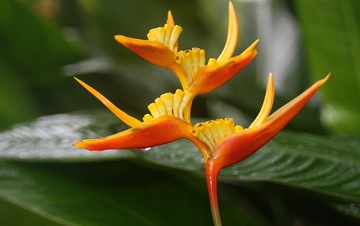Heliconia, derived from the Greek word helikonios, is a genus of about 100 to 200 species of flowering plants native to the tropical Americas and the Pacific Ocean islands west to Indonesia. Common names for the genus include lobster-claws, wild plantains or false bird-of-paradise. The last term refers to their close similarity to the bird-of-paradise flowers (Strelitzia). Collectively, these plants are also simply referred to as heliconias.
It is the sole genus of the family Heliconiaceae, but was formerly included in the family Musaceae. The APG system of 1998, and its successor, the APG II system of 2003, confirms the Heliconiaceae as distinct and places them in the order Zingiberales, in the commelinid clade of monocots.
The leaves of these plants are 15-300 cm (6 in-10 ft) long, oblong, growing opposite one another on non-woody petioles often longer than the leaf, often forming large clumps with age. Their flowers are produced on long, erect or drooping panicles, and consist of brightly colored waxy bracts, with small true flowers peeping out from the bracts. The growth habit of heliconias is similar to Canna, Strelitzia, and bananas, to which they are related.
Heliconias are grown for the florist’s trade and as landscape plants. The flower of H. psittacorum (Parrot Heliconia) is especially distinctive, its greenish-yellow flowers with black spots and red bracts reminding of the bright plumage of parrots.
(From Wikipedia, 14 August 2011)





